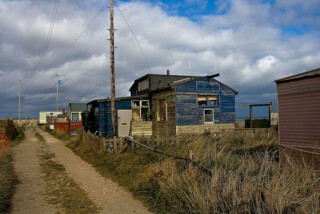‘South Riding’ Redux
Gillian Darley
As a well-behaved only child I spent time arranging, and rearranging, a set of woodblock buildings, mostly houses, red roofed, white walled: a little German village that I suspect the Bethnal Green Museum of Childhood would give their eye teeth for, had I still got it. A lot of grown-ups have been arranging garden cities on the carpet recently. Following Ebbsfleet’s green light, come the five proposals shortlisted for the Wolfson Economics Prize (in answer to the question: 'How would you deliver a new Garden City which is visionary, economically viable and popular?'). The proposals touch on complex variations of sites, strung out necklace-like, or attached barnacle-like to existing conurbations, and follow various planning and financial models, more or less interventionist. Shelter's adapts Ebenezer Howard's original Garden City ideals, according to which the increased value of the developed site accrues to the town and its residents.
Before the run-off in August, participants might want to read Winifred Holtby’s subtle, dense novel South Riding, with its rich background stew of local politics, municipal shenanigans, conflicting ideals and, eventually, a practical outcome. Her site is a run-down area outside the major town, Kingsport (Hull). There, in reality, was a large and much admired pre-First World War Garden Village, built by Reckitt's for company employees.
In Holtby's story, published in 1936, working-class semi-rural families live either in the cheerful squalor of the Shacks – 'two railway coaches, three caravans, one converted omnibus, and five huts', serviced by 'half a dozen tall narrow cupboards like up-ended coffins, cause of unending indignation to the sanitary inspectors' – or in the degraded Victorian terraces of East Kingsport.
Two sites for a garden village were in contention, Leame Ferry Waste, industrial badlands in need of drainage, and a plot ‘south of the Skerrow road, north of Garfield’. Everything is complicated by the councillors’ own priorities, political, social, moral and (especially) financial. One of the characters reads Kant in translation and speaks at Rationalist Press meetings; another is a conflicted gentleman farmer; there are a contrasting pair of non-conformists, one a skilled operator, the other a hypocritical tub-thumping preacher.
But the Council houses are for ‘a quite different type of ratepayer': this is 'the age of the easy purchase system, of wireless and electricity and Austin Sevens'. The tenants will, the councillors believe, aspire to walnut suites at 8/6 a week, hot water and pram sheds. They want good roads ready for when they can buy their own cars, as well as libraries, schools, clinics and 'cheap' secondary education. With all that, they will have ‘a quite new kind of communal sense’. In those ‘red-roofed, neatly ordered’ houses, with their gardens, play areas and amenities, no revolution would come, no ‘great co-operative commonwealth of free peoples... controlling their own lives’ as Astell (the Kantian) admits to Snaith (the non-conformist strategist). At the end of the book, the headteacher around whom the story revolves, Sarah Burton, sees the birth of the essentially bourgeois garden village from the air, the marked-out streets, the piles of bricks. She sees the future in the children who will live there, and her part in their improved lives.
